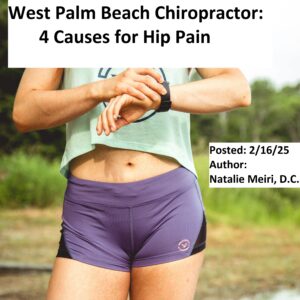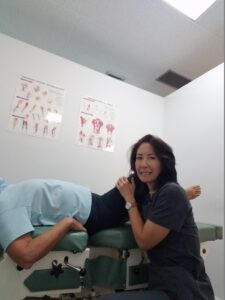
You may have had some trauma or injury involving your hip? Perhaps you have thigh pain from a sudden movement? Moreover, as a weight bearing joint, the hip is commonly affected by degenerative joint changes and soft tissue damage. Or you may think your pain is in the low back or buttocks when it is in fact due to your hip. Also, your hip pain may not be coming from your hip at all! This post is about West Palm Beach Chiropractor: 4 Causes for Hip Pain.
Hip Anatomy
The hip, like the shoulder, is considered a ball-and-socket joint. It is formed by the head of the femur (thigh bone) which sits in what’s called the acetabulum, a part of the pelvis. The head of the femur is large (ball) and the acetabulum (socket) is deep. The soft tissues (refers to non-bony structures that connect, support, or surround other structures) in your hip are:
- the muscles, which allow you to move.
- the tendons, which connect your muscles to the bone.
- the ligaments are bands of tough elastic tissue around your joints. They connect bone to bone, give your joints support, and limit their movement.
- the fascia – stretchy, thin, white fibrous tissue. All your muscles are enveloped in fascia.
- the bursae – fluid-filled pads that act as cushions at the joints. Bursae reduce friction between the surfaces of a bone and soft tissue.

1) Referral of Pain
Hip joint pain can be actually be coming from the L3 nerve root segment (low back nerve root). So the pain is a referred pain from the nerve at the L3 level of your low back. Of course, hip joint innervation is from segments L2 to S1.
Alternatively, hip pain can be the result of referral from the facets (small joints in between the vertebrae in the back of the spine) of the lower lumbar spine.
Furthermore, the knee also refers pain to the hip area. And the hip can refer pain to the knee.
2) Muscle Strain
The muscles working across the hip joint are subject to strain, either through overuse (chronic strain) or overstress (acute strain or trauma). A strain occurs when a muscle or tendon is overstretched or torn. Commonly strained hip muscles include: sartorius, rectus femoris, iliopsoas, hamstrings, and the adductors.
3) Bursitis
Trochanteric bursitis presents as pain felt primarily over the lateral (away from body) hip region. Additionally, this can be a result of overuse or direct injury. You may find tenderness at a specific point over the inflamed greater trochanter. The greater trochanter is a bony prominence located at the upper end of the femur (thigh bone) area of the hip. Typically, bursitis hip pain is often aggravated by going up stairs. Bursitis pain is usually described as deep and aching pain that began insidiously (came on gradually and without noticeable symptoms). Getting in and out of a car repeatedly can sometimes trigger hip brusitis.
4) Nerve Entrapment
Firstly, entrapment of several peripheral nerves can occur in association with hip pain and dysfunction. For instance, the femoral nerve lies close to the femoral head (top part of the thigh bone that fits into the hip socket). Indeed, trauma or swelling may produce entrapment. Subsequently, this can cause weakness of your hip flexors and tenderness in the groin area.
Secondly, another example would be the sciatic nerve entrapment. This occurs when the nerve passes through the piriformis muscle. Subsequently, the sciatic nerve may be compressed by the piriformis muscle. As a result, a sciatic radiculopathy (nerve root injury) with related motor and sensory changes may present.
Thirdly, the lateral femoral cutaneous nerve is prone to entrapment near the anterior superior iliac spine (ASIS). The ASIS is a bony projection on the ilium bone in the pelvis. The nerve passes through the lateral end of the inguinal ligament (band of connective tissue in the groin that connects the abdomen to the pelvis). Entrapment of the femoral cutaneous nerve creates a condition called meralgia paresthetica. It is characterized by a burning pain in the anterior and lateral (front and side) portions of the thigh.

Research on How Chiropractic Adjustments Can Help
A 2017 review in the Journal of the American Medical Association, found that spinal manipulation reduces lower back pain.
A2013 study published in Osteoarthritis and Cartilage found that patient education combined with 12 chiropractic treatments (twice a week for six weeks) were more effective for hip Osteoarthritis than a daily stretching program or patient education alone.</p>
Are you looking for hip pain relief from a West Palm Beach chiropractor? Call 561-253-8984 today for an appointment. Find out more about West Palm Beach Chiropractor: 4 Causes for Hip Pain and feel better today.
References:
Thomas Bergman, David Peterson, Chiropractic Technique Principles and Procedures, 3rd edition, 2011